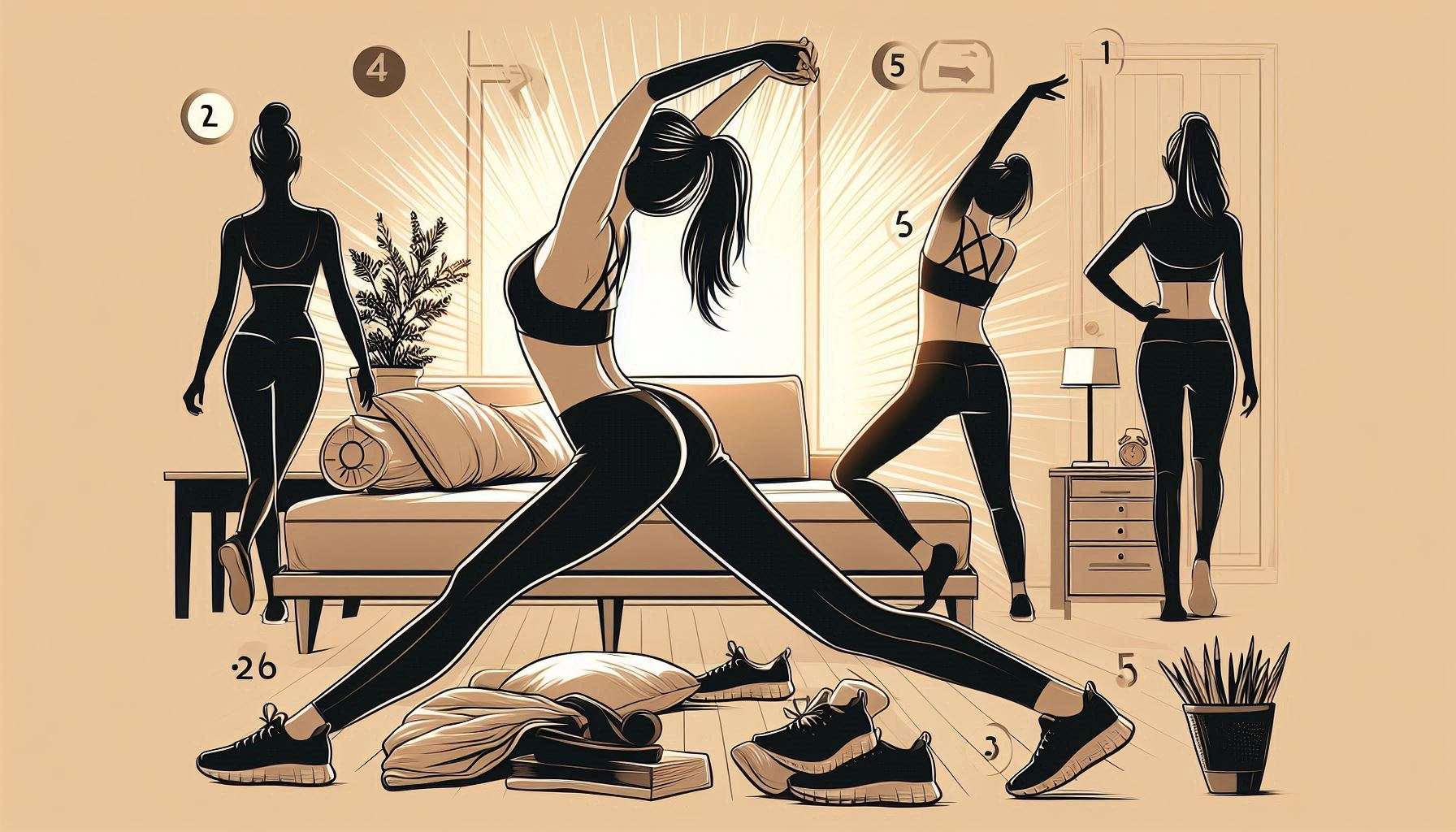Stretching and Flexibility: 7 Powerful Tips to Improve Your Health
Unlock greater mobility, prevent injuries, and boost overall wellness with these proven flexibility strategies.
1. Health Benefits of Stretching and Flexibility
Stretching and flexibility are the foundation of mobility exercises that keep your body agile and resilient. Regular flexibility training:
- Enhances range of motion in joints
- Reduces risk of muscle strains and injuries
- Improves posture and spinal alignment
- Boosts circulation and nutrient delivery
- Alleviates muscle tension and stress
Stretching and flexibility exercises are often overlooked components of a well-rounded fitness routine, yet they offer a wide range of health benefits that extend far beyond simply touching your toes. Incorporating regular stretching and flexibility work into your daily or weekly regimen can improve mobility, reduce the risk of injury, and even enhance mental well-being.
First and foremost, stretching increases joint range of motion. Over time, muscles and connective tissues can become stiff, limiting how far a joint can move. By gently lengthening muscles and tendons through dynamic (movement-based) and static (held) stretches, you help maintain or improve your body’s natural mobility. This greater range of motion not only makes everyday activities—like bending to tie your shoes or reaching for objects on a high shelf—easier and more comfortable, but also contributes to better posture by allowing your spine and shoulders to sit in their optimal alignment.
Improved flexibility also plays a critical role in injury prevention. Tight muscles are more prone to strains, tears, and overuse injuries, especially during sudden or high-intensity movements. When your muscles are flexible, they can absorb and distribute mechanical stress more evenly, reducing the likelihood of acute injuries during sports, exercise, or even routine tasks. For example, flexible hamstrings and hip flexors can help protect your lower back from excessive stress and pain, while a supple shoulder complex can decrease the risk of rotator cuff injuries.
Beyond the physical advantages, stretching provides significant benefits for circulation and recovery. When you stretch, you promote blood flow to the targeted muscles, delivering oxygen and nutrients that accelerate tissue repair. This is why many athletes incorporate stretching and foam-rolling into their cool-down routine: it helps clear metabolic waste—like lactic acid—and diminishes delayed onset muscle soreness (DOMS), allowing for quicker recovery between workouts.
In addition to these physiological effects, there are notable advantages to your nervous system and stress levels. Stretching activates the parasympathetic (“rest and digest”) branch of the autonomic nervous system, which counteracts the “fight or flight” response that tends to dominate modern, fast-paced lifestyles. As a result, even a brief stretching session can elicit a calming effect, lowering heart rate, reducing muscle tension, and alleviating feelings of anxiety. Many people find that incorporating mindful breathing into their stretching practice enhances these relaxation benefits, creating a mini “moving meditation” that supports mental clarity and emotional balance.
Finally, flexibility training can enhance performance in a variety of sports and activities. Whether you’re a runner, cyclist, weight-lifter, or yoga enthusiast, increased flexibility allows your body to move more efficiently and with less effort. This efficiency translates into improved power output, better technique, and a reduced risk of form-related injuries. For example, dancers who maintain high levels of flexibility can achieve more graceful extensions, while swimmers benefit from a greater shoulder range that contributes to longer, stronger strokes.
In summary, the health benefits of stretching and flexibility are multifaceted. By improving joint mobility, preventing injury, enhancing circulation and recovery, promoting relaxation, and boosting athletic performance, a consistent stretching routine becomes an indispensable tool for both physical and mental well-being. Whether you dedicate just 10 minutes a day or integrate longer sessions into your workout plan, the dividends paid in health and vitality make stretching and flexibility work a smart investment for everyone.
According to the Mayo Clinic, consistent stretching can help prevent age-related mobility loss and chronic pain.
2. Dynamic Stretching: Warm-Up for Success
Before intense activity, perform dynamic stretching to activate muscles and increase core temperature. Try:
- Leg Swings: 10 reps front-to-back and side-to-side per leg.
- Arm Circles: 15 seconds forward, 15 seconds backward.
- Walking Lunges: 10 steps each leg, with torso twists.
Dynamic stretching is a vital component of any effective warm-up routine, designed to prepare the body for physical activity and unlock peak performance. Unlike static stretching, which involves holding a position for an extended period, dynamic stretching uses controlled, active movements that mimic the motions of your sport or workout. Incorporating dynamic warm-up exercises such as leg swings, walking lunges, arm circles, and hip openers helps increase blood flow, improve joint mobility, and activate the neuromuscular system—making it an essential pre-workout strategy.
One of the primary benefits of dynamic stretching is enhanced sports performance. By engaging muscles through a full range of motion, you train your body to move efficiently during competition or training sessions. Improved flexibility and muscle activation not only boost power and speed but also contribute to better coordination and balance. Studies show that athletes who implement dynamic warm-ups experience higher jump height, faster sprint times, and stronger muscle contractions compared to those who only use static stretches.
Dynamic stretching also plays a critical role in injury prevention. Static, cold stretching before exercise can temporarily weaken muscle strength and increase the risk of strains. In contrast, dynamic stretching gradually raises muscle temperature, optimizes tendon elasticity, and prepares connective tissues for load-bearing activity. This warming effect reduces muscle stiffness and decreases the likelihood of common workout injuries, such as hamstring pulls or shoulder impingements.
To maximize the benefits of dynamic stretching, structure your warm-up with progressive intensity. Begin with low-impact movements targeting major muscle groups—like hip circles or torso twists—then advance to sport-specific drills, such as high knees or butt kicks. A well-rounded dynamic warm-up should last 8–12 minutes, culminating in movements that closely replicate the demands of your chosen activity.
Incorporating dynamic stretching into every workout or game-day routine not only primes your body for success but also sets the foundation for long-term flexibility gains and injury resilience. Embrace dynamic warm-up exercises today to elevate your performance, protect your muscles, and achieve consistent, safe progress in your fitness journey.
These movements prepare your body for exercise and reduce injury risk. Learn more about dynamic warm-ups in our Warm-Up Routines Guide.
3. Static Stretching: Cool-Down Essentials
After workouts, static stretching helps lengthen muscles and promote recovery. Hold each stretch for 20–30 seconds:
- Hamstring Stretch: Sit and reach toward toes.
- Quad Stretch: Stand and pull heel to glutes.
- Chest Opener: Clasp hands behind back and lift.
Static stretching is the cornerstone of a safe and effective cool-down routine, essential for enhancing post-workout recovery and preserving flexibility. Incorporating targeted static stretches—held for 20–30 seconds each—helps lengthen muscle fibers, promote blood flow, and reduce lactic acid buildup after intense exercise. Key static stretches include hamstring stretches, quad stretches, calf stretches, shoulder crosses, and triceps overhead stretches. By focusing on major muscle groups, you improve overall range of motion and joint health, which contributes to long-term injury prevention.
A structured cool-down centered around static stretching not only alleviates muscle tightness but also signals your nervous system to transition from high-intensity activity to a rested state. This gentle approach to flexibility training supports muscle recovery and decreases delayed onset muscle soreness (DOMS), allowing you to maintain consistent performance in subsequent workouts. To maximize benefits, perform static stretching on a soft surface and breathe deeply, ensuring each stretch feels comfortable yet challenging.
Integrating static stretching into your post-exercise cool-down also reinforces proper movement patterns and posture. Over time, consistent static stretching can correct muscular imbalances, enhance athletic performance, and safeguard against strains and sprains. Make static stretching a non-negotiable part of your fitness regimen to optimize muscle recovery, preserve flexibility, and support sustainable, injury-free progress.
Static stretches improve flexibility over time. For guided sessions, explore our Stretching Video Library.
4. Strength & Mobility Combo Exercises
Combining strength moves with mobility drills accelerates flexibility gains. Include:
- Deep Squat to Stand: Transition slowly between standing and deep squat, 10 reps.
- World’s Greatest Stretch: Lunge, rotate torso toward front leg, 5 reps each side.
- Thoracic Bridge: From seated, lift hips and reach arm overhead, 8 reps each side.
Strength & mobility combo exercises seamlessly blend strength training with mobility drills to unlock full-body performance and injury resilience. By incorporating compound movements—like the deep squat to stand, world’s greatest stretch, and thoracic bridge—you target multiple muscle groups while enhancing joint health and flexibility. These functional fitness routines improve core stability, dynamic balance, and muscular coordination, making everyday tasks easier and boosting athletic output.
For example, pairing reverse lunges with a spinal rotation not only builds lower-body strength but also promotes hip and thoracic mobility. Similarly, combining pull-ups with scapular retractions enhances upper-body power and shoulder range of motion. Perform these strength & mobility combo exercises 2–3 times per week as part of a holistic workout plan to accelerate muscle activation, reduce stiffness, and maintain long-term movement efficiency. Embrace these integrated drills to achieve a stronger, more agile, and injury-resilient body.
These compound drills build stability while enhancing joint mobility.
5. Consistency & Progress Tracking
To see lasting improvements in flexibility training, maintain a routine:
- Stretch 3–5 times weekly, 15–20 minutes per session
- Keep a flexibility journal to note your range of motion gains
- Use apps like FlexibilityApp for reminders and progress logs
Consistency and progress tracking are the cornerstones of any successful flexibility and mobility program. By establishing a regular stretching routine, you create the habit loop necessary for lasting mobility gains. Use a flexibility journal or a mobility app—such as the highly rated FlexibilityApp—to log each session, note range of motion improvements, and record stretch duration. Tracking progress not only boosts motivation but also highlights areas needing extra focus, ensuring balanced joint health and muscle recovery.
To maintain consistency, schedule stretching sessions at the same time each day—ideally post-workout or first thing in the morning. Set clear, SMART goals (Specific, Measurable, Achievable, Relevant, Time-bound), like increasing hip flexor flexibility by 10 degrees in four weeks. Review your mobility metrics weekly, adjusting your dynamic and static stretch mix to target stubborn tightness. Incorporate periodic flexibility assessments, such as the sit-and-reach test, to quantify range of motion improvements.
Leverage reminders and calendar alerts to eliminate missed sessions and use progress photos to visually track posture correction and muscle elongation. By combining consistent practice with diligent progress tracking, you’ll accelerate flexibility training, reduce injury risk, and sustain long-term performance enhancement.
Tracking keeps you motivated and highlights areas needing extra focus.
6. Posture and Ergonomics for Flexibility
Poor posture hinders flexibility. Incorporate:
- Desk Stretches: Chest and hip flexor openings every hour
- Ergonomic Setup: Chair height, monitor at eye level
- Movement Breaks: 2-minute stretch breaks to counteract sitting
Good posture and proper ergonomics are essential for maximizing flexibility and preventing chronic muscle tension. Maintaining an upright spine with neutral pelvic alignment reduces stress on joints and enhances overall spinal alignment, which is crucial for effective flexibility training. Incorporating ergonomics for flexibility in your daily routine—such as adjusting your chair height, positioning your monitor at eye level, and using a supportive lumbar cushion—creates an ergonomic workspace that promotes optimal posture improvement.
When seated, keep your feet flat on the floor and your knees at a 90-degree angle to minimize hip tightness and improve mobility exercises. Standing desks and desk posture tools like anti-fatigue mats encourage frequent posture changes, reducing static loading on muscles. Simple posture correction drills—such as scapular retractions and chin tucks—reinforce proper alignment and activate deep stabilizing muscles that support joint health.
Regular breaks for desk stretches—including seated thoracic rotations and standing hip flexor stretches—help alleviate muscle stiffness and maintain range of motion throughout the day. By prioritizing workplace ergonomics and consistent flexibility routines, you’ll experience reduced risk of injury, enhanced muscle recovery, and long-term gains in functional flexibility.
Proper ergonomics supports muscle balance and prevents tightness.
7. Lifestyle Habits to Support Mobility
Beyond exercise, adopt daily habits to enhance flexibility:
- Stay hydrated to keep tissues supple
- Consume anti-inflammatory foods—berries, fatty fish, nuts
- Prioritize 7–9 hours of sleep for recovery
- Manage stress with yoga or meditation
Incorporating effective lifestyle habits to support mobility is key for sustaining long-term flexibility and preventing chronic stiffness. First, prioritize hydration—drinking at least 8 glasses of water daily keeps your connective tissues supple and enhances joint health. Dehydrated muscles and fascia become tight, limiting your range of motion during mobility exercises.
Next, adopt an anti-inflammatory diet rich in omega-3 fatty acids (salmon, walnuts), colorful fruits and vegetables (berries, leafy greens), and lean proteins to reduce muscle soreness and promote tissue repair. Foods high in antioxidants, like turmeric and ginger, further combat inflammation and support faster active recovery.
Quality sleep—7 to 9 hours per night—is another crucial factor. Deep sleep stages release growth hormone, aiding muscle regeneration and improving flexibility training outcomes. Establish a consistent bedtime routine that includes gentle yoga or breathing exercises to calm the nervous system and enhance mobility gains.
Integrate regular foam rolling sessions into your self-care regimen. Trigger-point release with a foam roller or massage ball breaks up fascial adhesions and improves muscle pliability, making static and dynamic stretches more effective.
Finally, manage stress through daily mindfulness practices—meditation, nature walks, or progressive muscle relaxation—to prevent tension buildup that can impair functional flexibility. By combining these lifestyle strategies, you’ll optimize your body’s ability to move freely and enjoy enduring improvements in mobility.
Wellness habits complement stretching and flexibility efforts.
External & Internal Resources
For deeper dives and guided programs:
Conclusion
Stretching and flexibility are vital for better health and longevity. By following these 7 powerful tips—dynamic warm-ups, static cool-downs, strength-mobility combos, consistent practice, ergonomic habits, and supportive lifestyle choices—you’ll unlock greater mobility, reduce pain, and enhance overall well-being. Start today and feel the difference!



77zik9
re2z4x
sr7hg3